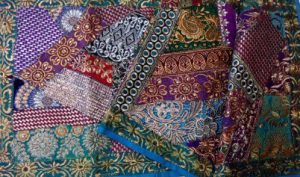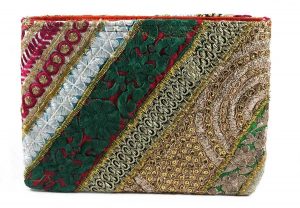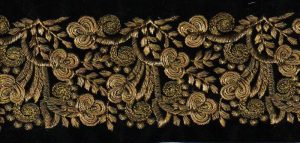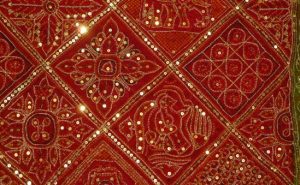Prepared using thin metallic threads made from gold and silver, zari and zardozi was introduced in India by the Mughals. Owing to its rich texture and costly nature, it was worn in the most important cermonies and events. In Gujarat, Junagadh, Cambay, Surat and Dahod are famous for zardozi work. Communities use a variation of techniques such as zardozi, marodi for their traditional wear such as abha, ijar and odhani.





The intricate art of zardozi in Agra done on velvet is said to have been introduced by the Portuguese. Zardozi, which is a persian word- zar meaning gold and work is dozi- is a craft where wire purls, beads, sequins and spangles are couched on to the fabric with a needle. It is an immensely glittering and heavily encrusted embroidery. Zari ka kaam on the other hand is a chain stitch done at a fast pace using zari and silk with a fine hooked needle called ari. It is also known as haathari, ari kaam and fancy kaam. Traditinal items such as purses, handbags, jewellery boxes, caps, jackets, slippers as well as contemporary pieces such as lehenga-choli/gathered skirt and blouse and sari are crafted by the artisans. Tools such as a rectangular wooden frame called karchob, butter paper stencil/khakha, hooked needle/ari and hammer to flatten the wire embroidery are needed for the process.
Different styles of Indian embroidery have been handed down from generation to generation: zardozi, chikankari, sujuni, kantha, kasuti, toda, mirror work. The passion for embroidery in India has led to great experimentation in the field, with several styles, creating dazzling effects such as the 'stained glass' look, the long cross stitch, rice stitch, textured panels and much more. One can see embroidery on wall hangings, saris, textiles and garments, incorporating unique motifs and patterns.
Zardozi is one of the most beautiful embroidery styles of India. Of Persian origin the word Zardozi literally means gold-work as it describes the use of gold, silver metal wires, cords, purls and sequins, which are couched through hand sewing on to textiles. Brought to India by the Mughals it was used by court and aristocracy to make up garments, wall hangings, royal tents and the trappings of the elephants and horses used by the emperor.
Zardozi continues to be used extensively in clothing and home decoration in India and for export. Painstakingly and delicately done by hand on the Karchappa floor frame, creations in zardozi work are timeless. Two forms of Zardozi continue to be practiced - the zardosa where the work is elaborate, intricate and heavy done on expensive and heavy weight silk, velvet or satin; and the lighter kamdani which can be done on light-weight fabrics. With huge demand and the necessity for speed the needle has been replaced in the couching by the ari hooked needle.
Different styles of Indian embroidery have been handed down from generation to generation: zardozi, chikankari, sujuni, kantha, kasuti, toda, mirror work. The passion for embroidery in India has led to great experimentation in the field, with several styles, creating dazzling effects such as the 'stained glass' look, the long cross stitch, rice stitch, textured panels and much more. One can see embroidery on wall hangings, saris, textiles and garments, incorporating unique motifs and patterns. Zardozi is one of the oldest and most beautiful embroidery styles of India. It is used extensively in clothing and home decoration. Painstakingly and delicately done by hand, creations in zardozi work are timeless, unbounded by the shackles of trends.



